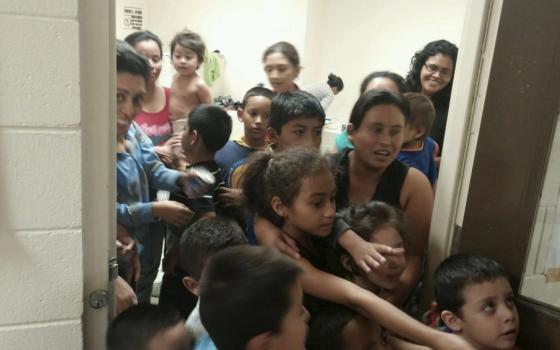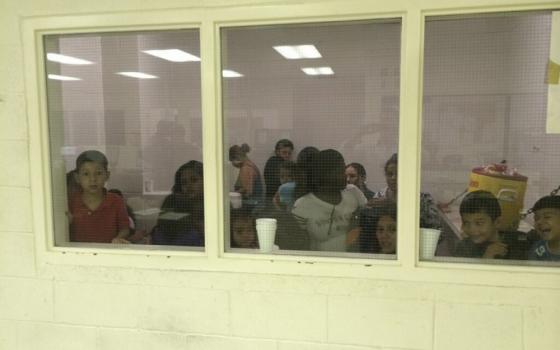Eight shelters in the Chicago area hold 450 immigrant children who crossed the border illegally and without a parent or guardian.
Once a month, an interfaith group visits one of the shelters to present a program with a theme like home or gratitude. The children draw pictures and sing a simple song. The adult leaders invite the children to light a candle. “You can tell that some of them really make that a time when they are praying,” said Benedictine Sr. Benita Coffey, one of the volunteers.
But the ministry is momentary. Volunteers are not to form personal connections with the children, and by their next visit, most of them will have moved on. Most likely they have been sent to live with family while they await their deportation proceedings.
As lawyers, social workers and volunteers, women religious and their partners help care for the growing number of unaccompanied alien children entering the United States. Their access to children, however, is increasingly brief. With thousands of immigrants overwhelming an already broken system, people of good will do what they can do to serve each individual in front of them.
Customs and Border Protection has apprehended about 47,000 unaccompanied minors in the past eight months and expects that number to climb to more than 90,000 by the end of the fiscal year, Sept. 30. A Nogales, Ariz., center will hold up to 1,500 children while they are being processed.
The surge of children has come from Honduras, El Salvador and Guatemala. From fiscal year 2011 to today, the number of unaccompanied children stopped at the border from these three countries has increased nearly nine-fold to about 35,000. Some reportedly allow themselves to be caught.
The children and youths are only to stay in the custody of Customs and Border Protection for 72 hours, though advocates have found this rule to be violated and some children to face harsh conditions. And as the surge has worsened there has been more criticism. At the Nogales processing center children have been photographed sleeping on plastic bins on a concrete floor.
Shelter life
After initial processing the children are transferred to the custody of the Office of Refugee Resettlement, which partners with private organizations, including the Catholic church, to operate shelters and foster care programs. An ORR spokeswoman reports that there are about 6,500 beds in about 90 facilities across 14 states.
The number of facilities may be growing. An announcement on ORR’s website dated June 6 advertises funding opportunities for additional shelters. In the meantime, about 1,200 children are being temporarily housed at Joint Air Force Base in San Antonio, Texas, and the Naval Base Ventura County in California. The Department of Defense also announced that Fort Sill, Okla., would be used to house about 600 children.
Women religious work both in shelters and foster care programs, but ORR policy restricts them from discussing their work with media. The policy is intended to protect children, who could be victims of trafficking, the ORR spokeswoman said.
Many who work with unaccompanied children, though, say the shelters they visit are positive places. The children have the right to classroom education, mental and medical health care, case management services and socialization and recreation.
After troubled lives in their home country and an often-traumatizing journey, the children often find the shelter to be a respite.
“One child had said that he had never slept in a bed before,” said Elizabeth Camarena, associate director of Casa Cornelia Law Center in San Diego. The center, which was started by the Society of the Holy Child Jesus, provides legal services to the children in the San Diego shelters.
Another boy told her he was thankful for the shelter, saying, “When I took a shower, I was thanking God for having him bring me to these angels.” He had been severely dehydrated when picked up.
While Chicago’s eight shelters can hold 450 children on a given day, San Diego’s shelters are small – 10 or 15 children each. The adults working at the facility are truly caring people, Camarena said. She describes one shelter as a house with four acres, a pony and space to play soccer and basketball.
Southwest Keys operates the San Diego shelters, and according to its website, it is the largest provider of services for unaccompanied children, with 20 shelters across California, Arizona and Texas.
In El Paso, St. Pius X Catholic Community works with the Southwest Keys shelters to provide religious services to the children. While the Chicago ministry is new, St. Pius’ Rico ministry is six years old and allows the children to spend time away from the shelter during their stay.
Every Tuesday and Thursday, a group of children goes to the church, and volunteers receive them with hugs and smiles. They gather in a circle and sing and pray. They discuss a theme with a story, do an arts and crafts project and have a snack.
On Sundays, volunteers from the church visit the shelters to meet with those who are not allowed to leave the premise; shelters fall under a range of service and security levels, some offering more freedom than others.
The Rico Ministry has 10 different themes that they can talk about, but children never have to go through a repeat. They often leave within a few weeks. “Sometimes we see the children only once,” said Lupita Nájera-Clarke, who volunteers on Tuesdays.
Even in just a few hours, though, you can see a transformation, she said. Often the children are depressed and scared. Most of the adults they have encountered on their journey – from gang members and corrupt police to border patrol officers – cannot be trusted.
The volunteers do not pry into their situations, but will listen if children want to talk. “Some of them out of the blue start talking about what happened to them, and others just say, ‘I don’t want to talk about it,’” she explained.
Nájera-Clarke sees 14-year-old girls who are pregnant. “We don’t want to ask about the dad – we don’t know if it was consensual or if it was rape – but you can see in their faces that they’re really sad.”
A few weeks ago, the volunteers asked the children to help them with a memorial service. They asked the children to write the name of somebody that they lost on a white balloon.
One girl, Nájera-Clarke said, “literally filled the balloon with names of people she had lost to violence – aunts, uncles, cousins.” All of the children had lost at least one loved one to violence in their home country.
Nájera-Clarke hopes that she can make them feel at home and give them hope. “We laugh with them, we try to make them have a happy moment when they are with us,” she said. “When they leave, they hug you very tight and they tell you, ‘I’m going to miss you.’”
Moving through the system
While short interactions with volunteers may raise the children’s spirits, they are more problematic for those trying to give the children legal advice.
In FY 2011, ORR reported that children stay at shelters for an average of 72 days. According to a fact sheet released in May, that average is down to 35 days. Kids in Need of Defense, a non-profit that connects unaccompanied children to pro bono lawyers, reports that children can move out of the shelters as quickly as two or three days.
Before release the children are supposed to be given a know-your-rights training program and be screened by a lawyer to determine if they are “at risk” in their home country, potentially qualifying them for legal relief to stay in the United States.
Casa Cornelia Law Center has one lawyer and one paralegal working with children, Camarena said, and they may have just one opportunity to meet the child in person and gain his or her trust.
Screenings based on a single meeting often are not sufficient to determine eligibility for legal relief, KIND reports. Due to their age, communication challenges and lack of trust, children may not reveal their abuse or fears on the first meetings with a strange adult.
When children stayed in the shelters longer, Casa Cornelia Law Center would ensure that every unaccompanied child in San Diego was represented throughout their immigration proceedings. The children did not necessarily win the right to stay in the United States, but lawyers often won them voluntary departures so that they did not have a deportation order on their record, restricting future, lawful entry.
“At least from our perspective, it’s not an issue of not having legal counsel for these children,” says Sr. Ann Durst, a member of the Society of the Holy Child of Jesus and a lawyer who founded Casa Cornelia Law Center and remains on the board. “But the situation now is that things are moving so quickly because of the increased numbers that there is not adequate time to provide a diligent legal assessment for these children.”
Nationally, 85 percent of children are placed with sponsors, often family members, who live in the United States, but they are still in deportation proceedings. Federal funds do not pay for their representation in immigration court, though they are given information on how to find pro bono representation.
The Vera Institute of Justice, which coordinates legal services for unaccompanied children, estimates that 40 percent of unaccompanied alien children are entitled to immigration relief. A United Nations High Commissioner for Refugees report found that 58 percent of unaccompanied youth were “forcibly displaced” and may need international protection from harm.
Both child advocates and critics of the system, however, worry that once released to sponsors, the children will fall through the cracks. It’s unclear what government agency is responsible for them, a 2012 report by the Vera Institutes concluded.
Undocumented sponsors and friends might advise youth to lie low, just as they have done successfully for years. Fearing their own deportation, they may not take them to court, even if the child is eligible for benefits.
According to what KIND says are “unofficial statistics,” more than 30 percent of unaccompanied youth do not show up to their immigration hearings and are deported in absentia.
This strategy may work for them until they are adults but then on a routine traffic stop, there is a deportation order is revealed, Camarena explained. At that point it’s too late for them.
“My fear is that they’re going to become this underground [population]," Camarena said. They’ll be “another undocumented immigrant with a deportation order.”
The need in front of them
Franciscan Sr. Suzanne Susany, a pastoral minister turned immigration lawyer in Pittsburgh, has represented a handful of unaccompanied children. Her first case was a 15-year-old boy from Guatemala who made it past Border Patrol.
In Pittsburgh, he was working from early morning to late at night in a restaurant to repay his debt to his uncle, who paid for the coyote who got him to the city.
There’s a cultural disconnect with many of the unaccompanied minors, Susany said. The teenage boys see themselves as adults and expect to work in the United States, though the U.S. sees them as children who should be in school.
A good Samaritan noticed that the boy attended church alone and agreed to sponsor him. Susany was able to get him Special Immigrant Juvenile status, arguing that his parents had abandoned him. Now, he is living with his sponsor and graduating from high school.
But another of Susany’s underage clients simply decided to skip court. “He just decided he wasn’t going to do it.”
They may be driven from their home by fear, but the young migrants also come to the United States with hope. “There’s this idea when you’re young that you can do just about anything, that you’re going to make it work,” Susany said. “I think they just think they’re going to be able to pull it off; they’re going to be a lucky one.”
Susany and others working with unaccompanied children do not have all the answers on how to solve the problem. The United States and Central American countries must address the violence and poverty pushing people to flee, and immigration reform, they say, is a must.
Advocates want to see a more continuous system, with legal representation and follow-up services for all unaccompanied children. The system would ensure that children are either safely returned to their home country or fully integrated into American society.
But as thousands of children cross the border, the most they can do is meet the needs of the children in front of them.
“You can’t do everything, but you do what you can and you do it as well as you can,” Susany said. “You really have to trust that God is in this.”
[Megan Sweas is a freelance journalist based in Los Angeles who writes about social and economic justice issues and world religions.]


